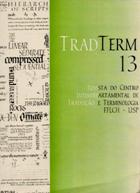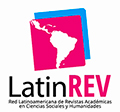Orlando: a história revisitada pela literatura e pelo cinema
DOI:
https://doi.org/10.11606/issn.2317-9511.tradterm.2007.47474Keywords:
Audiovisual translation, intersemiotic translation, literature, cinema.Abstract
It is with Orlando that Virginia Woolf introduces the fictional narrative in a new and amazing time experience, as if projecting the internal stream of consciousness in the supposed exterior reality, that is, history revisited by the biography narrated in a relative space-time. The character is Vita Sackville-West, her friend and lover who goes through centuries keeping memories from different epochs mixed to her personal experiences lived in both sexes. Freely as she travels through history Woolf approaches to themes like androgyny, homosexualism and the position of women in society. The present work aims at observing how Sally Potter interprets the novel Orlando in her adaptation of 1992 and whether she designs intertextuality in a semiosis that unveils the translation process. In such extent, some points need to be considered; firstly, the semiotic aspects peculiar to both compared systems - cinema and literature - followed by the analysis of the literary work in relation to its narrative structure and the iconic-metaphorical elements that delineate the character as well as the periods he/she lives and comparatively, the proposals made by Potter, having as theoretical basis the semiotics theory conceived by Peirce; the intersemiotic theory by Plaza and the adaptation studies developed by Cattrysse.Downloads
Download data is not yet available.
Downloads
Published
2007-12-18
Issue
Section
Adaptação Fílmica
License
Autores que publicam nesta revista concordam com os seguintes termos:
- Autores mantém os direitos autorais e concedem à revista o direito de primeira publicação, com o trabalho simultaneamente licenciado sob a Licença Creative Commons Attribution BY-NC-SA que permite o compartilhamento do trabalho com reconhecimento da autoria e publicação inicial nesta revista.
- Autores têm autorização para assumir contratos adicionais separadamente, para distribuição não-exclusiva da versão do trabalho publicada nesta revista (ex.: publicar em repositório institucional ou como capítulo de livro), com reconhecimento de autoria e publicação inicial nesta revista.
- Autores têm permissão e são estimulados a publicar e distribuir seu trabalho online (ex.: em repositórios institucionais ou na sua página pessoal) a qualquer ponto antes ou durante o processo editorial, já que isso pode gerar alterações produtivas, bem como aumentar o impacto e a citação do trabalho publicado (Veja O Efeito do Acesso Livre).
How to Cite
Alves, S. F. (2007). Orlando: a história revisitada pela literatura e pelo cinema. TradTerm, 13, 187-204. https://doi.org/10.11606/issn.2317-9511.tradterm.2007.47474








